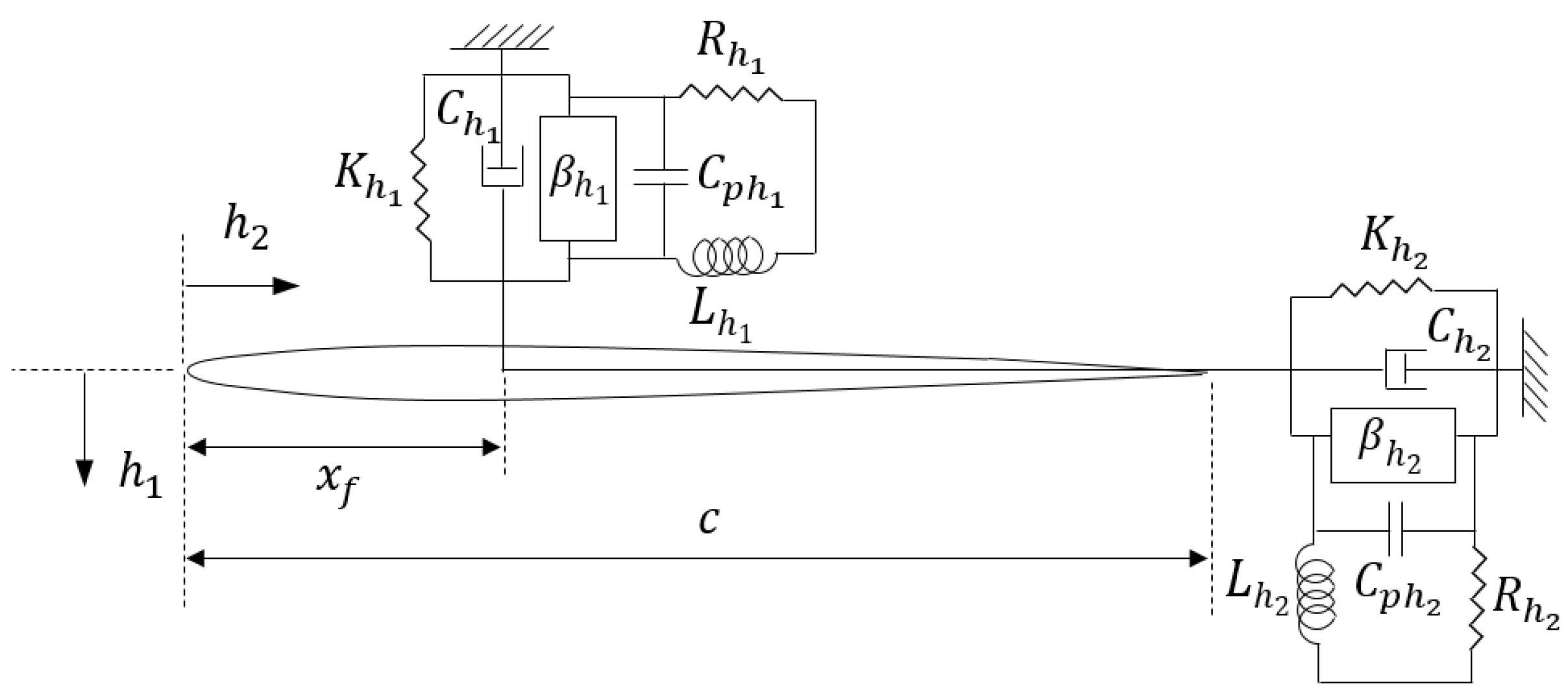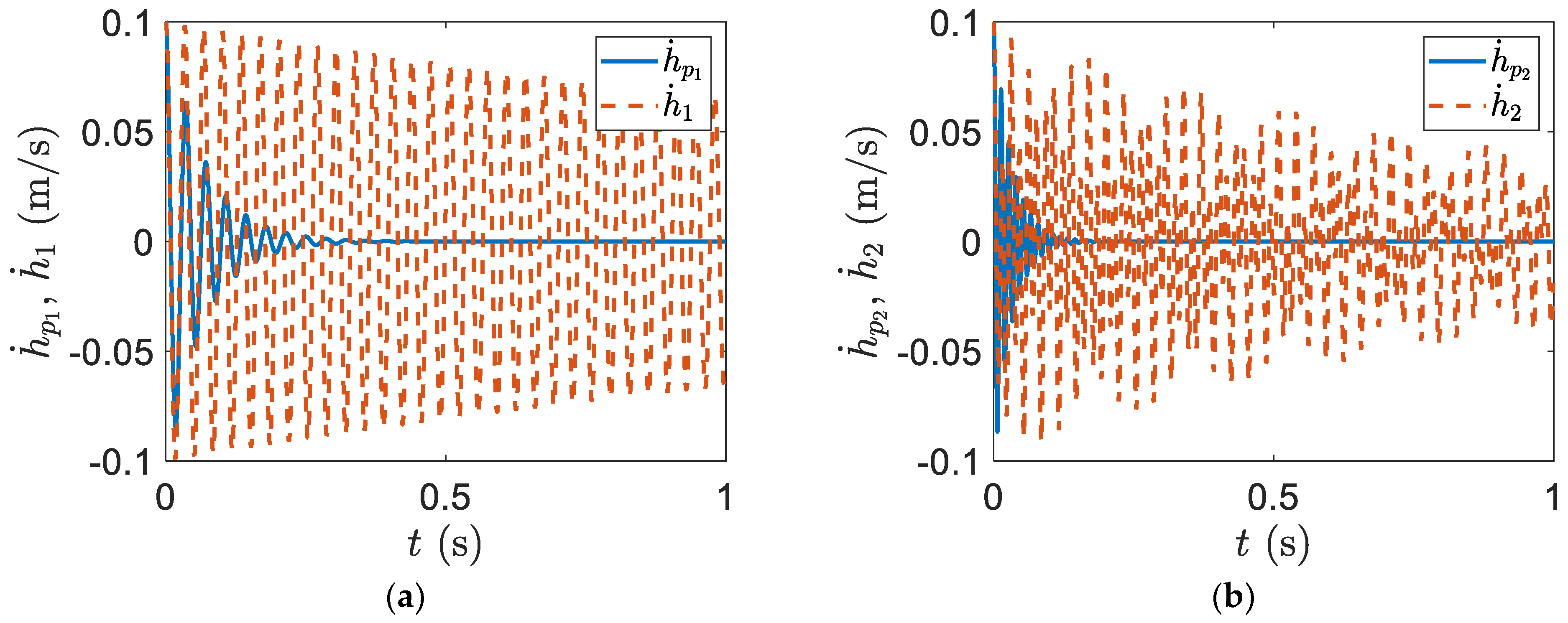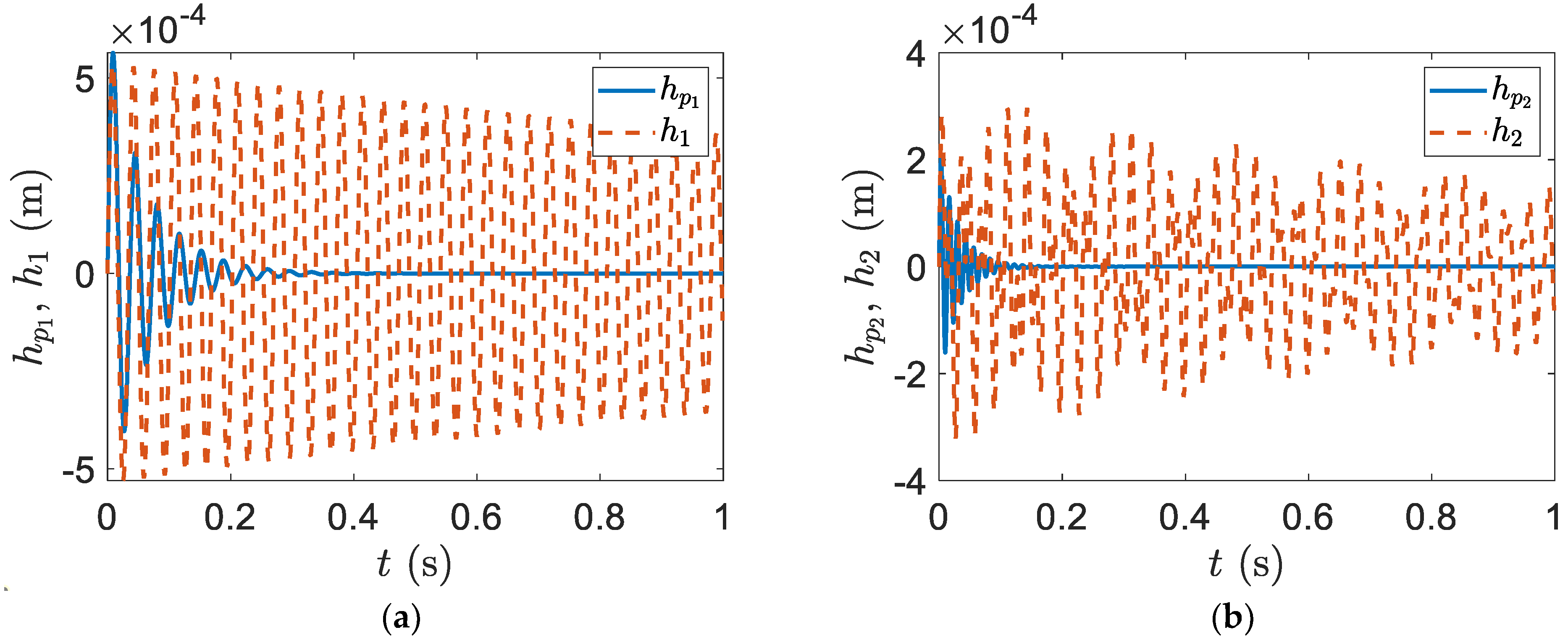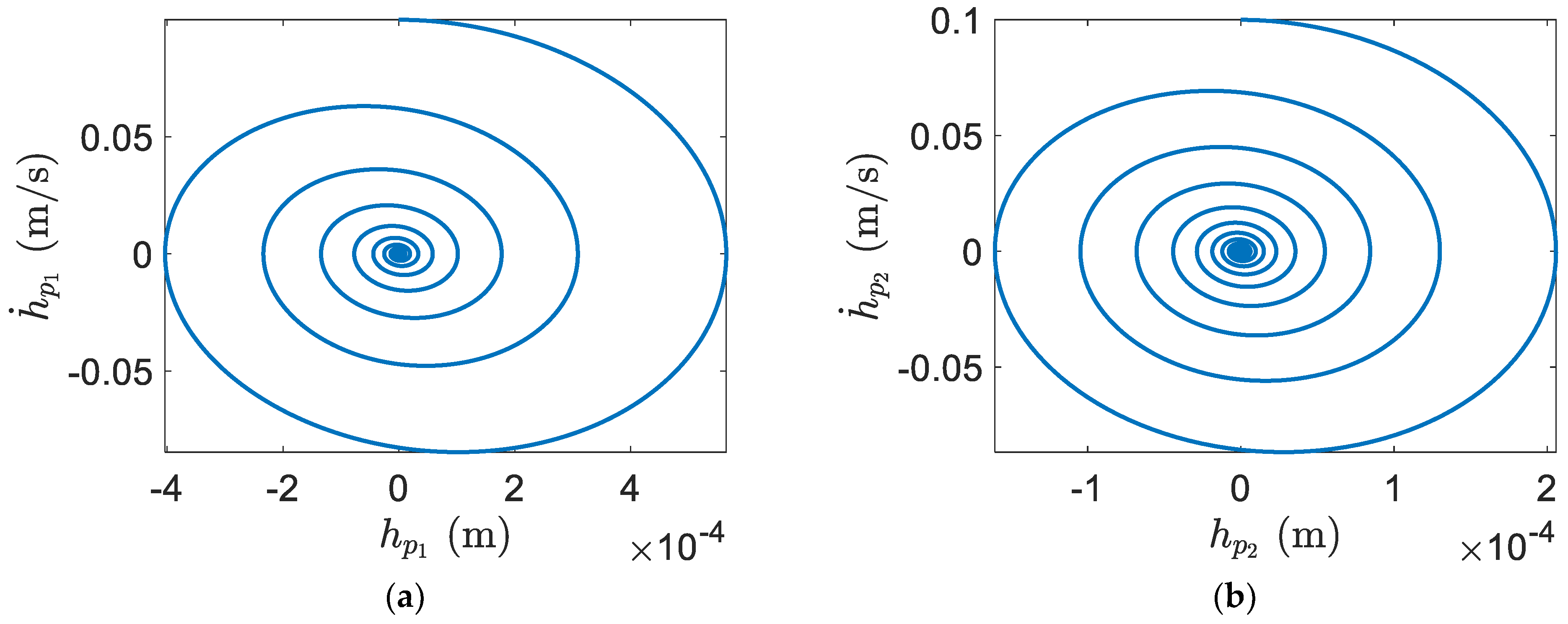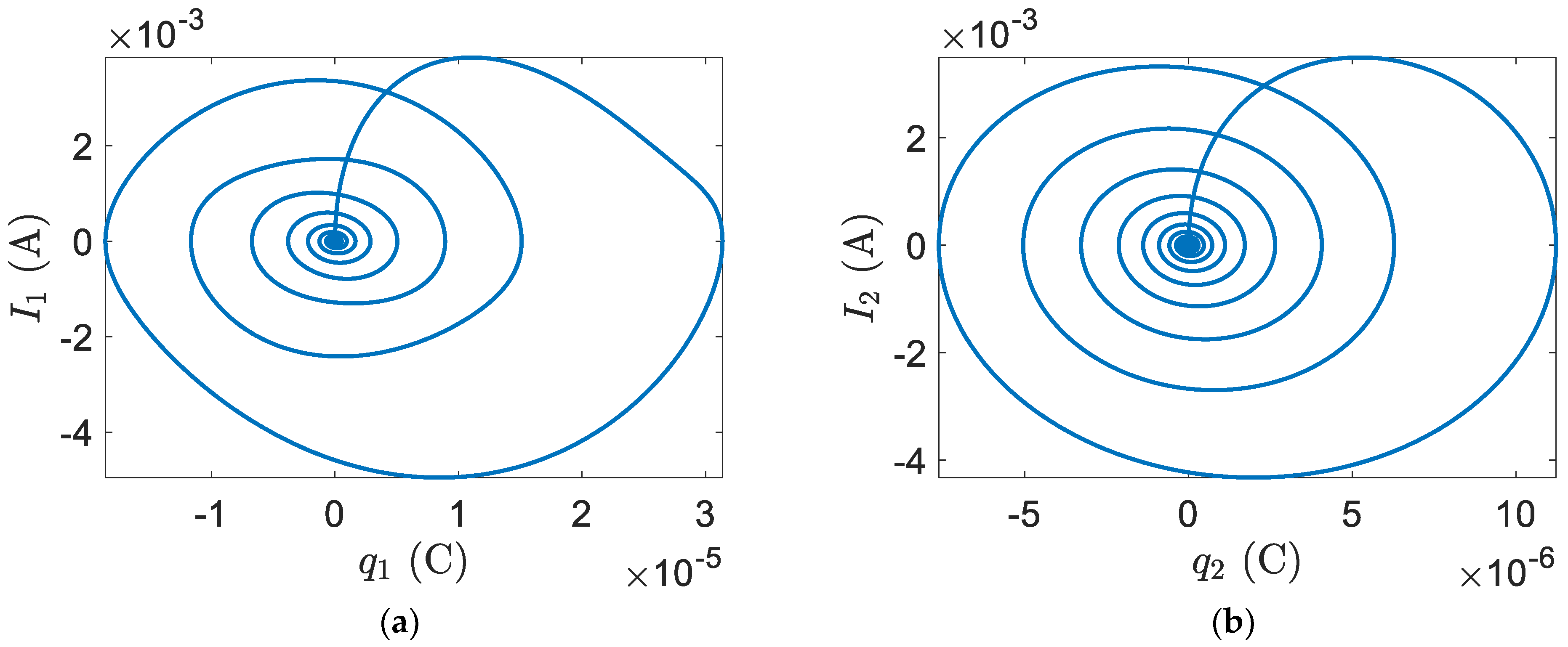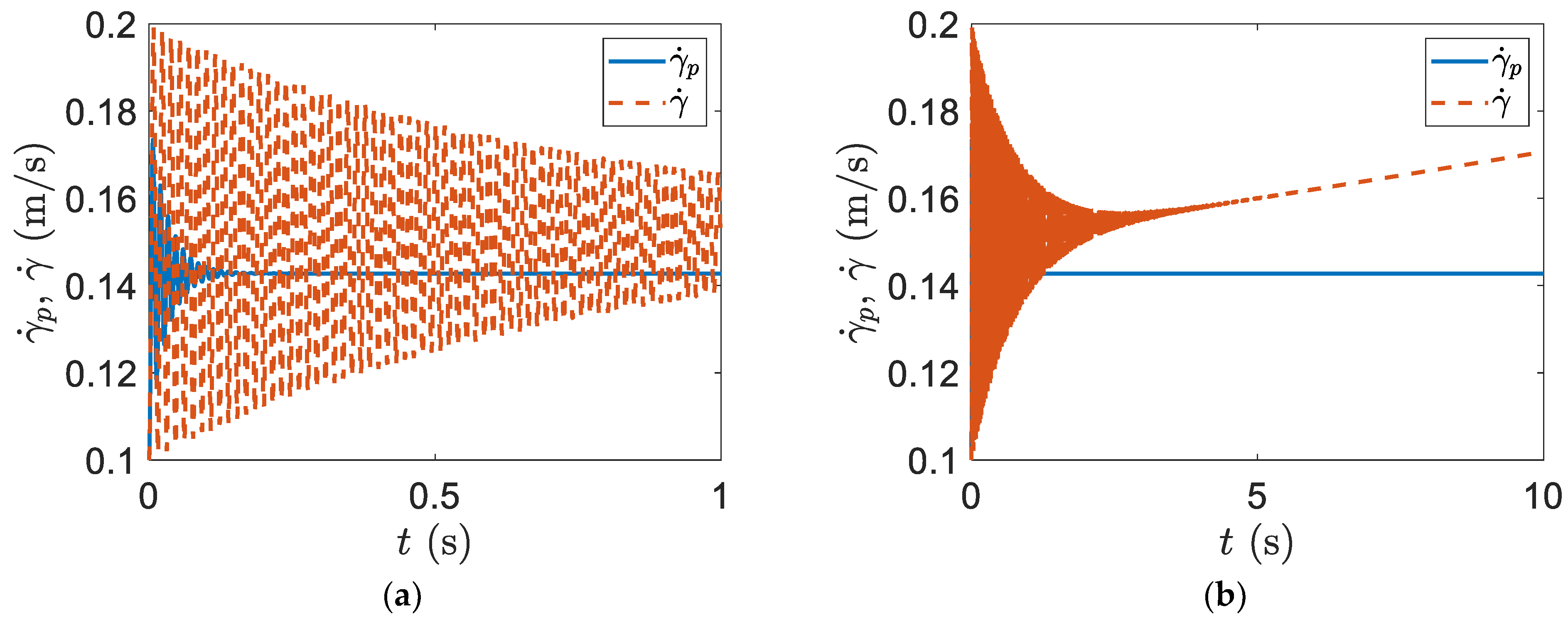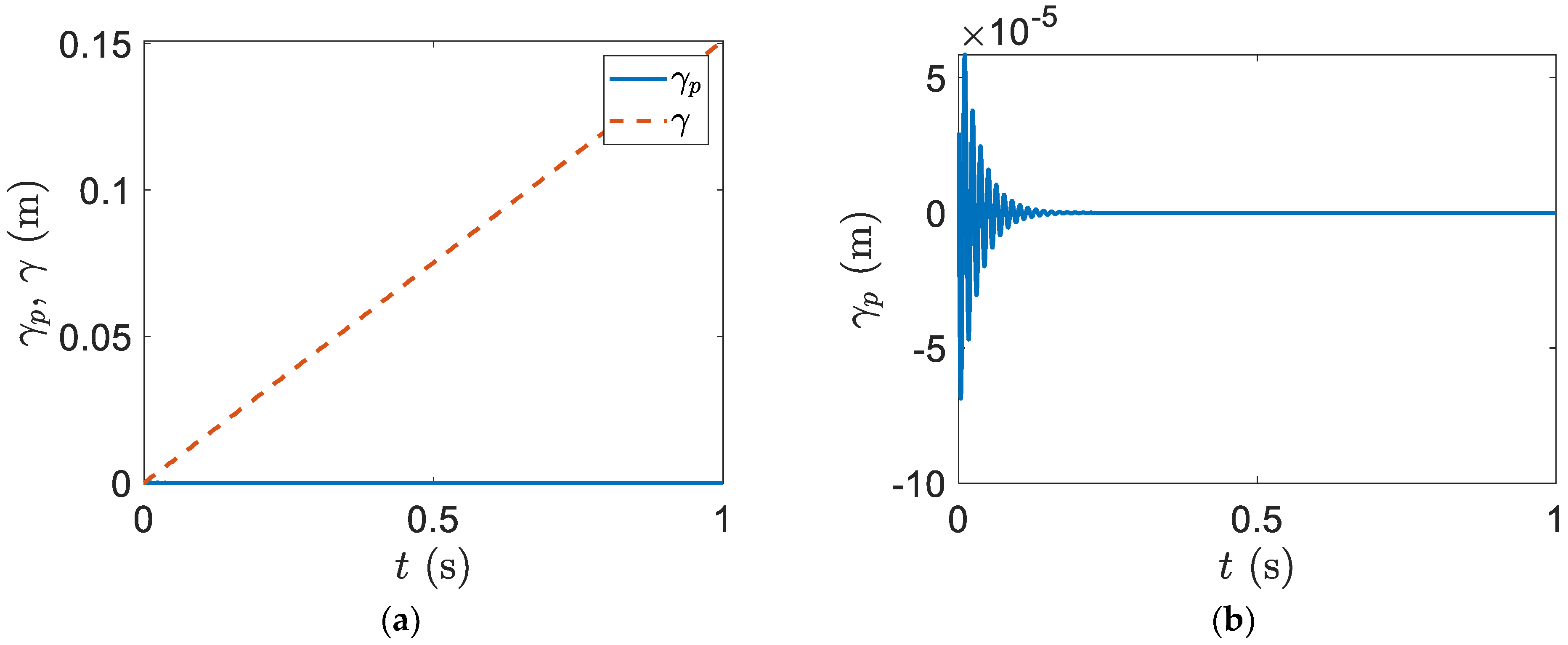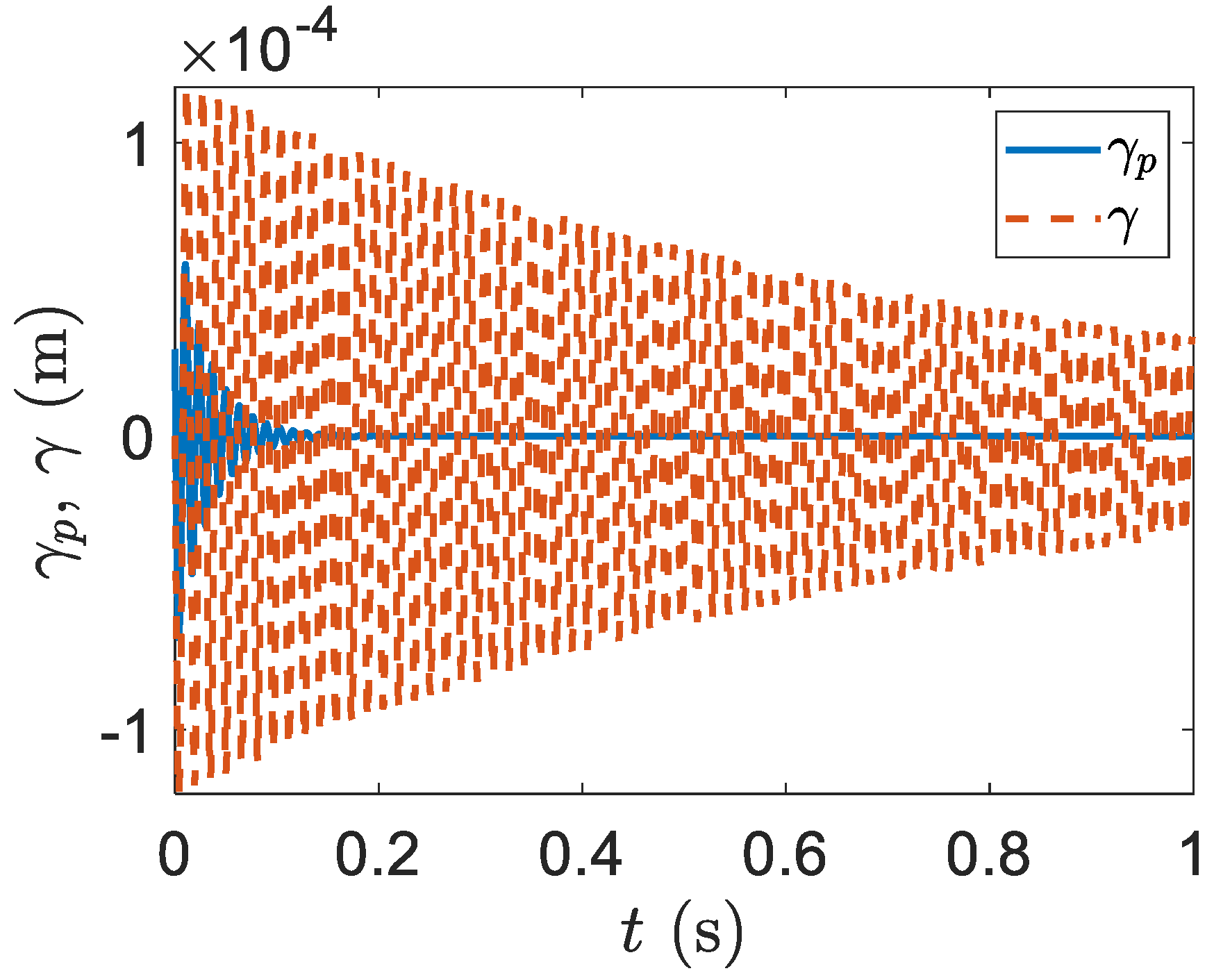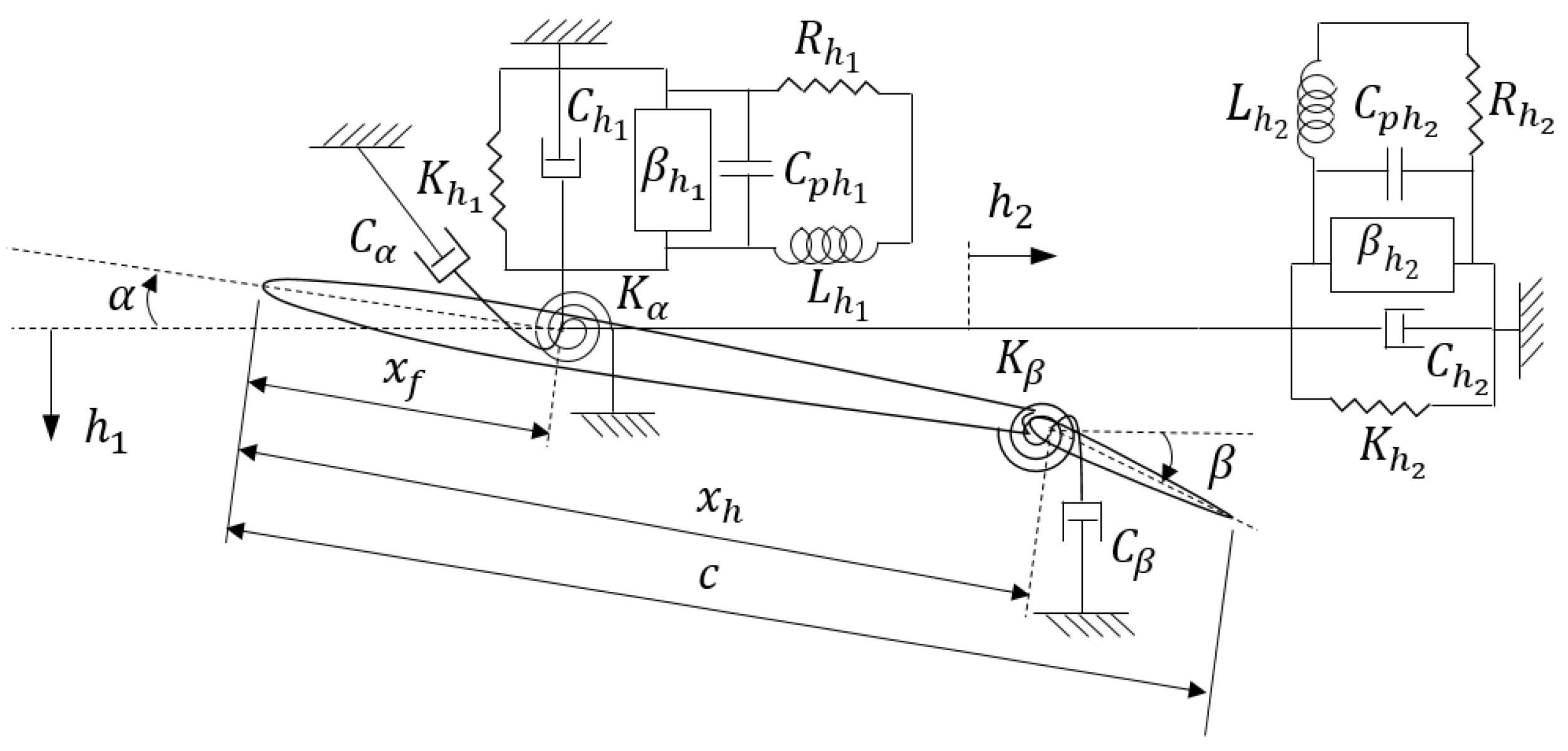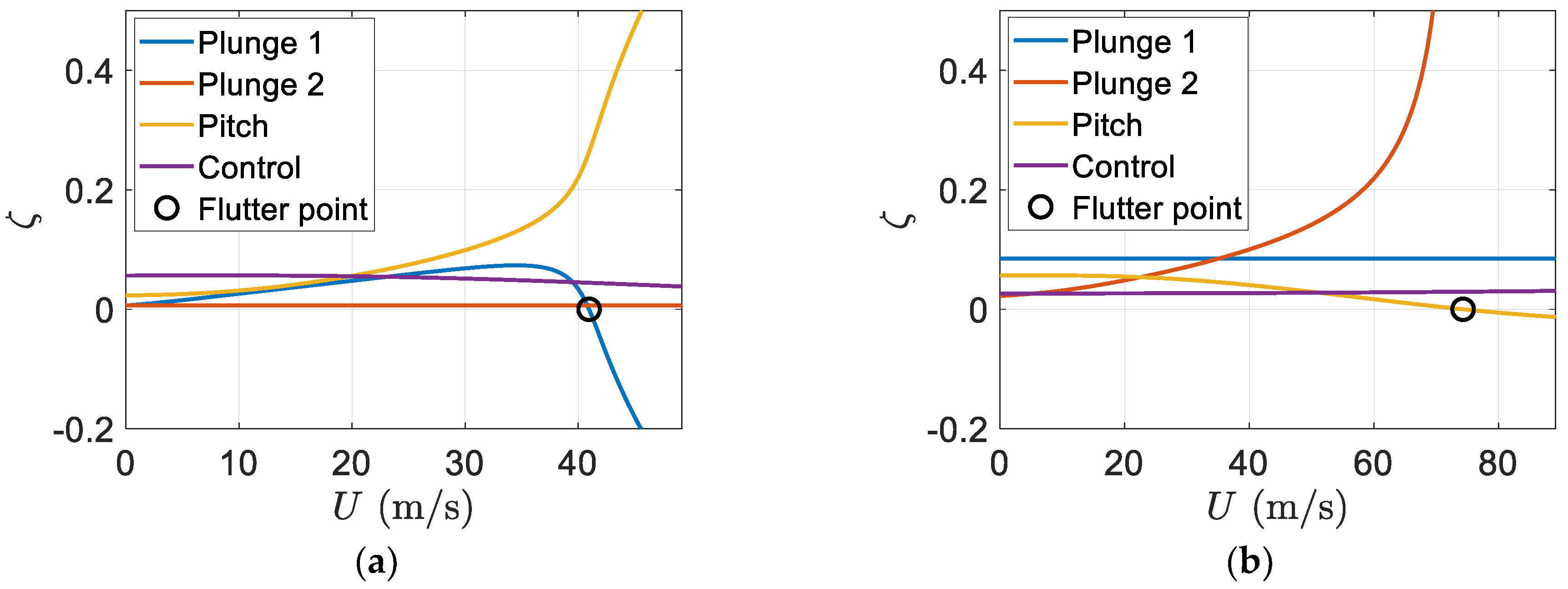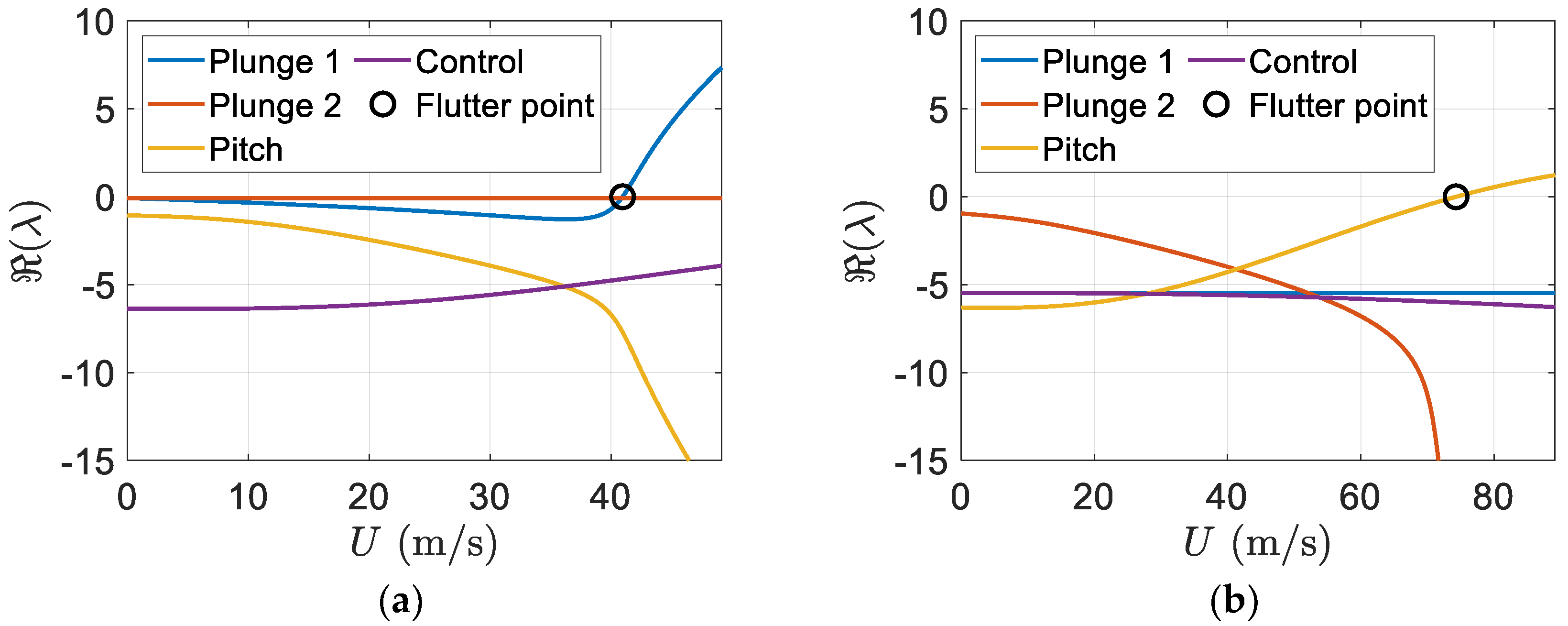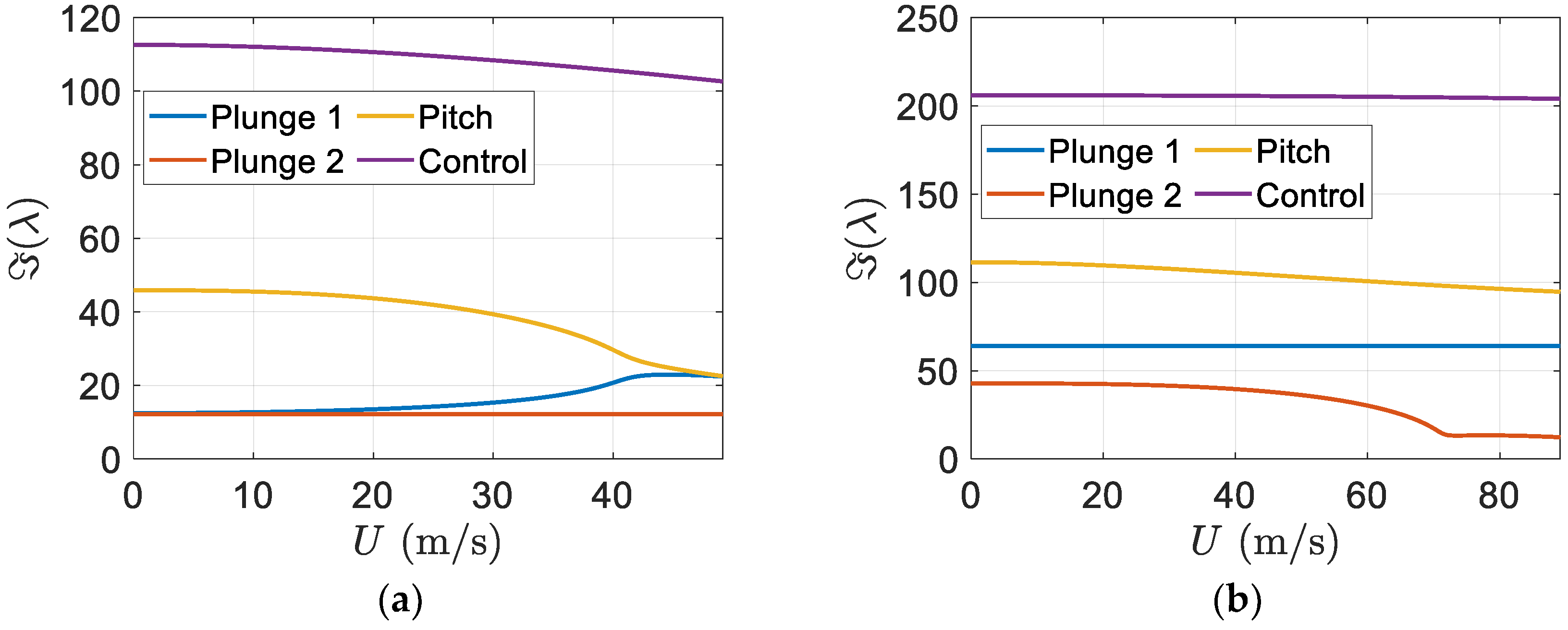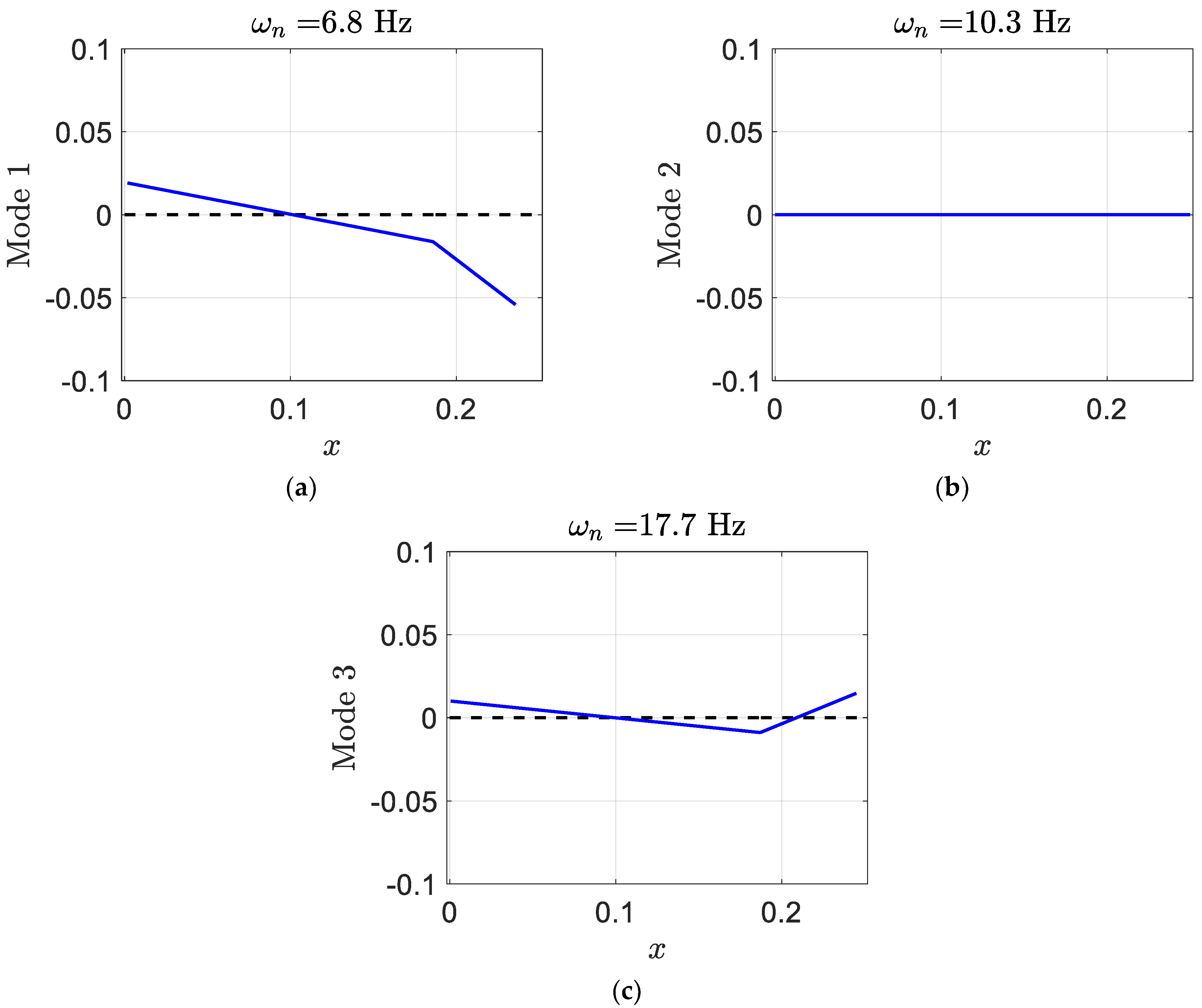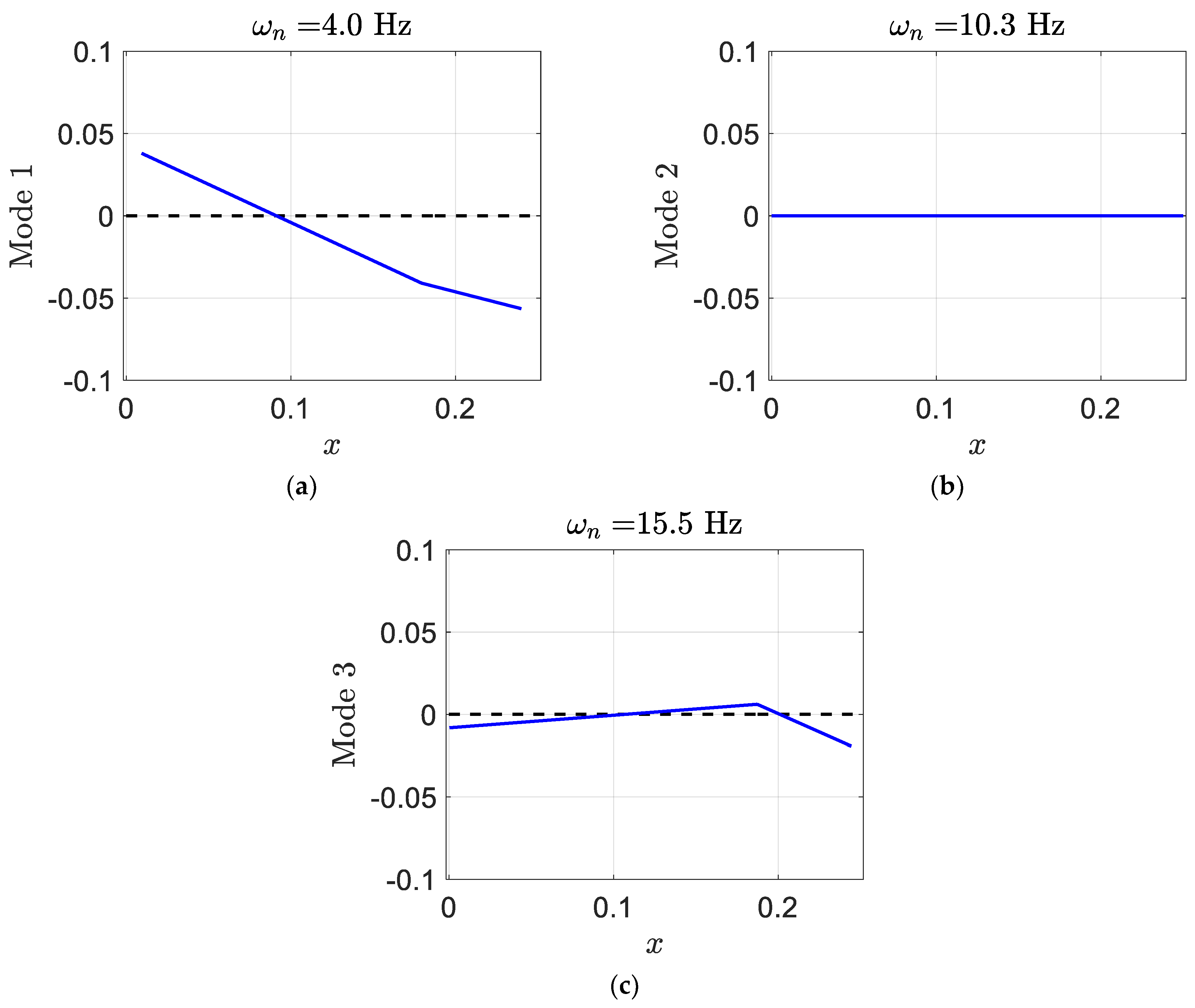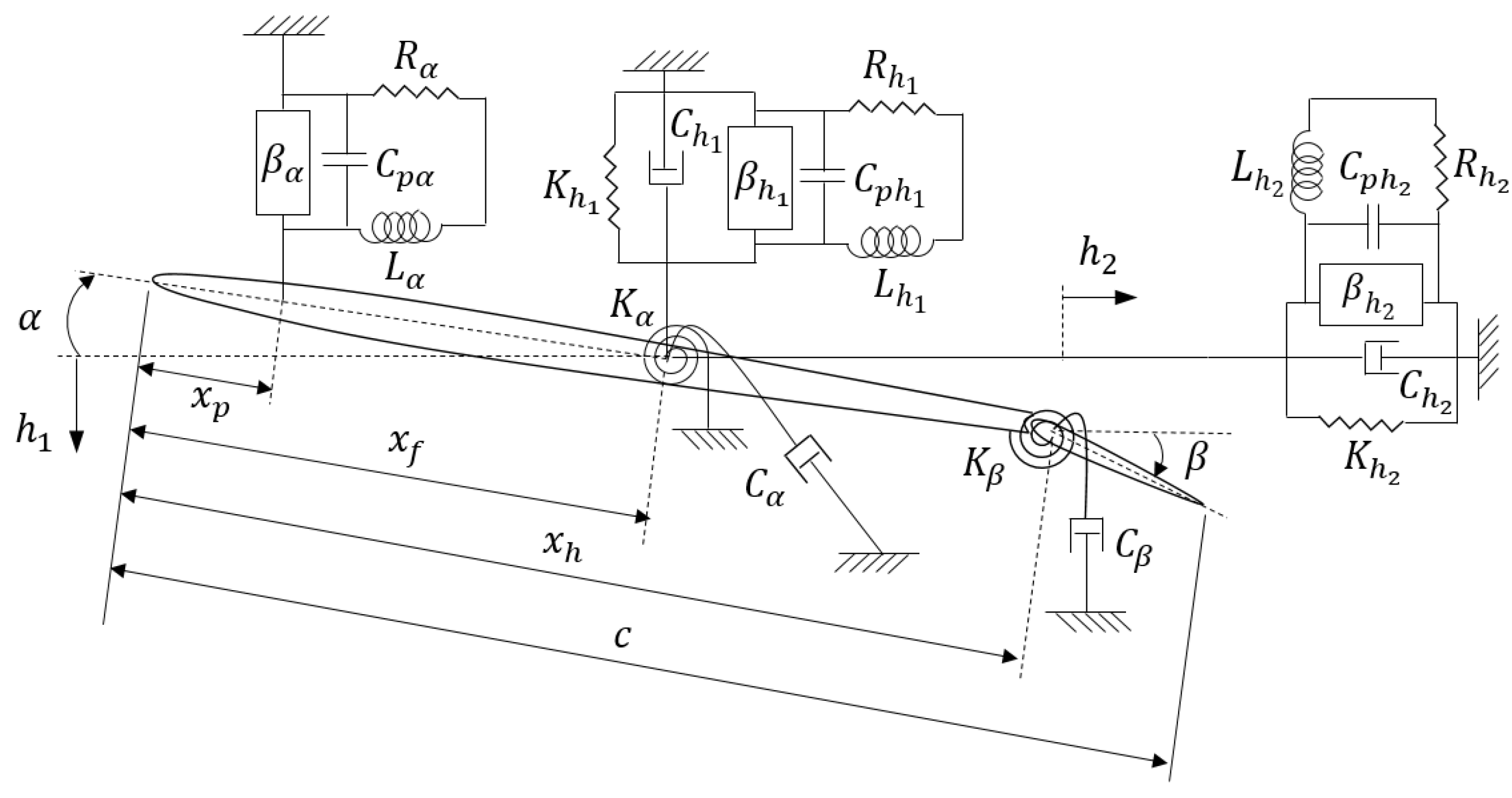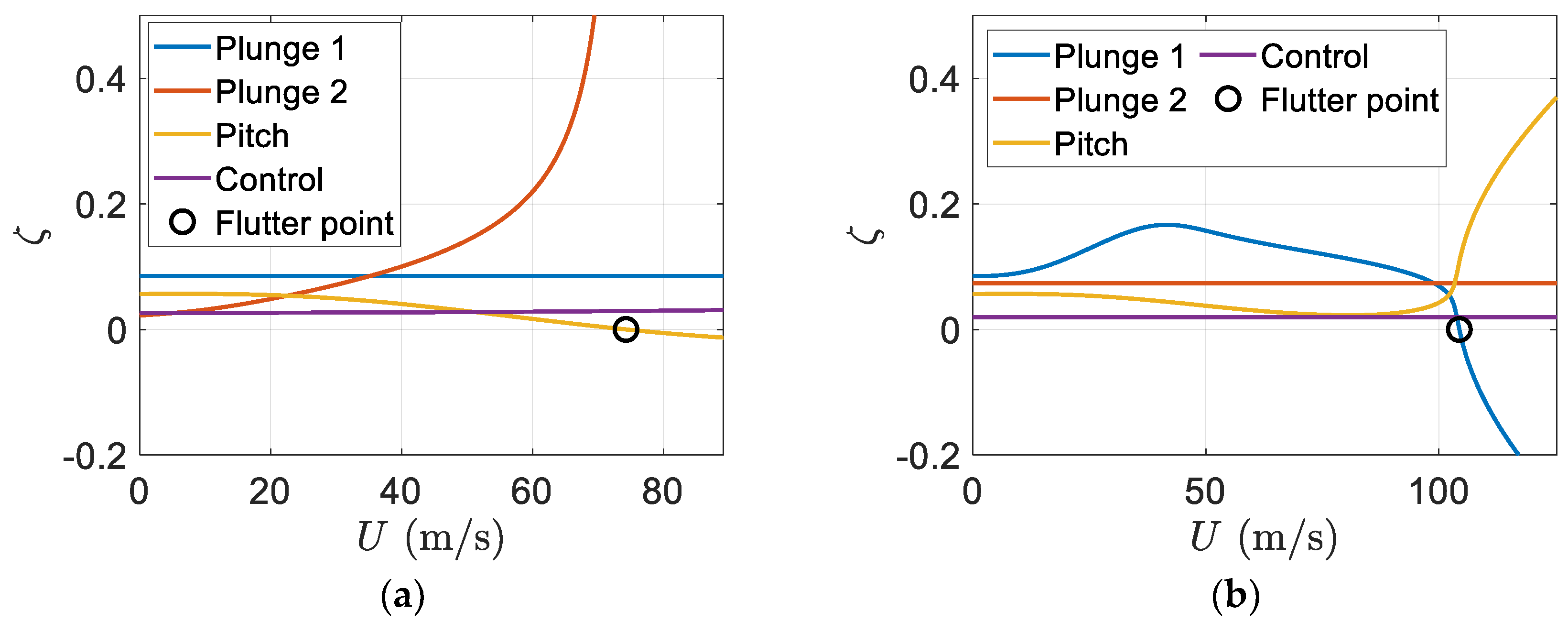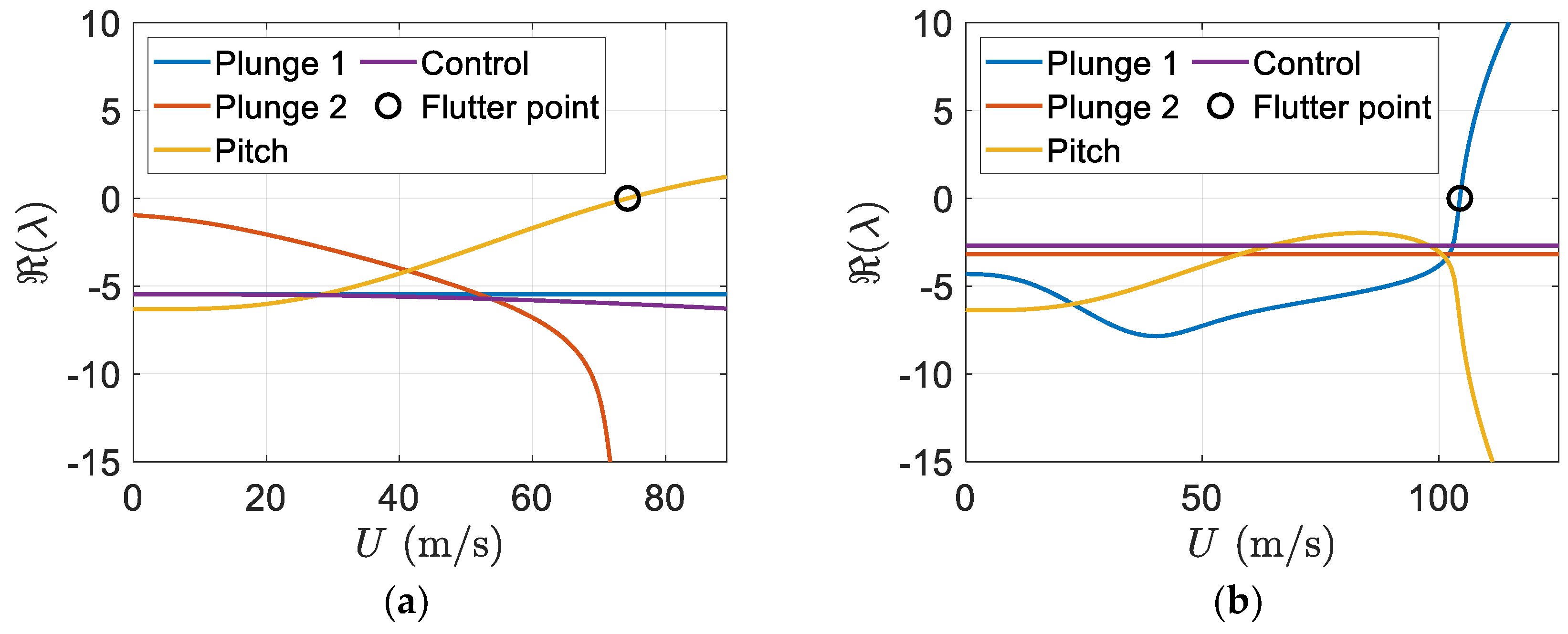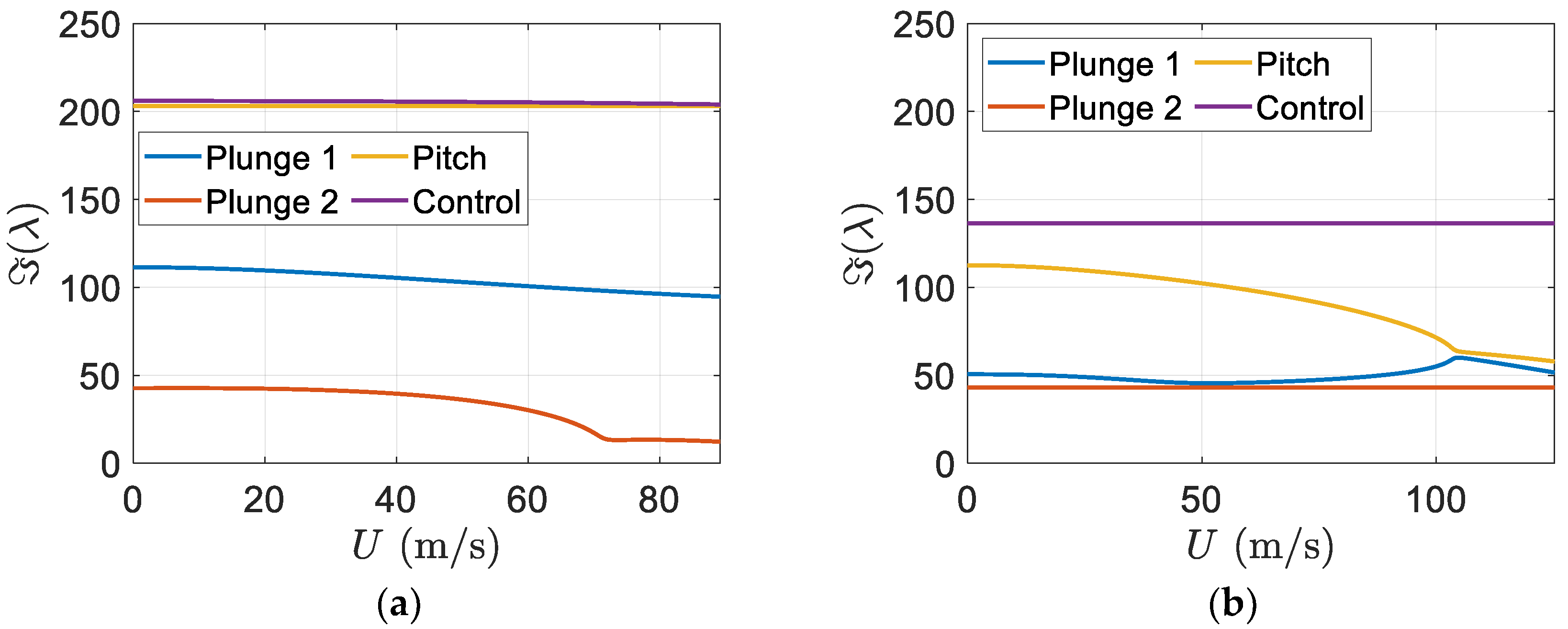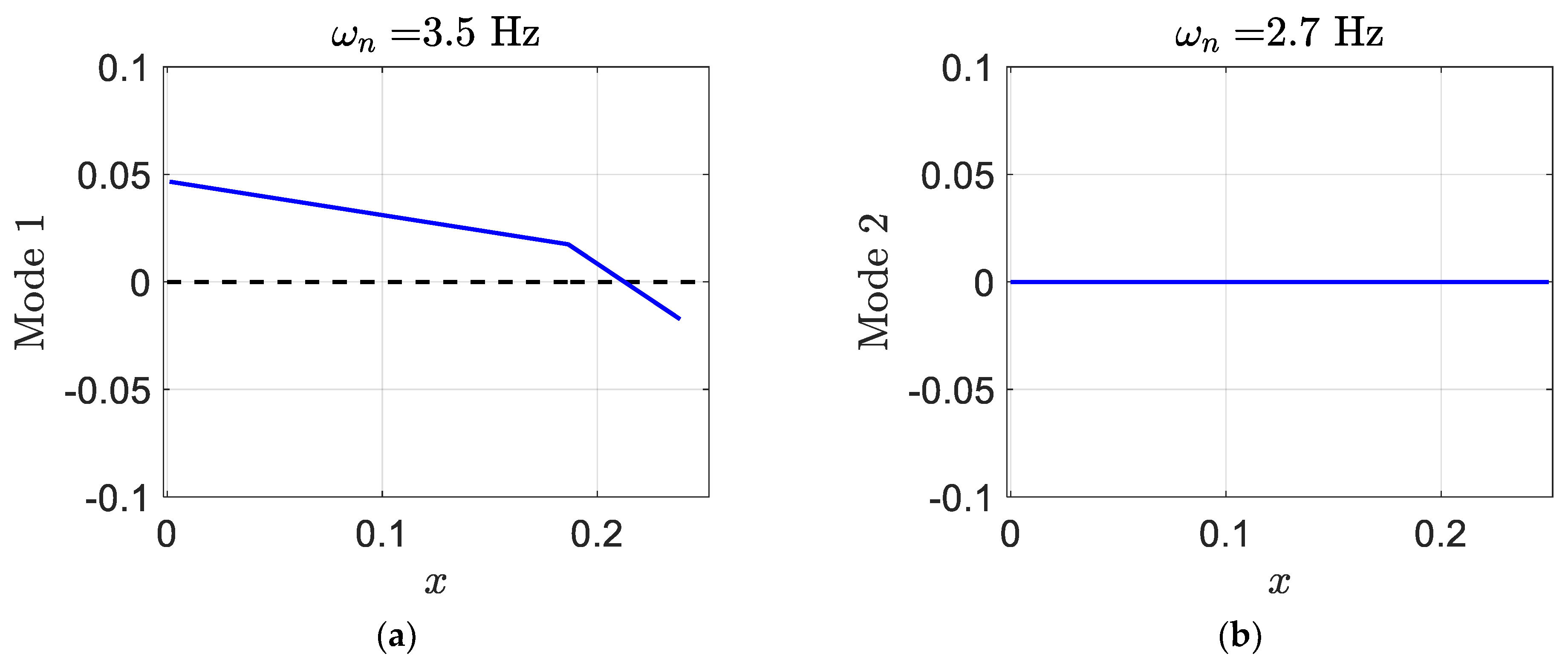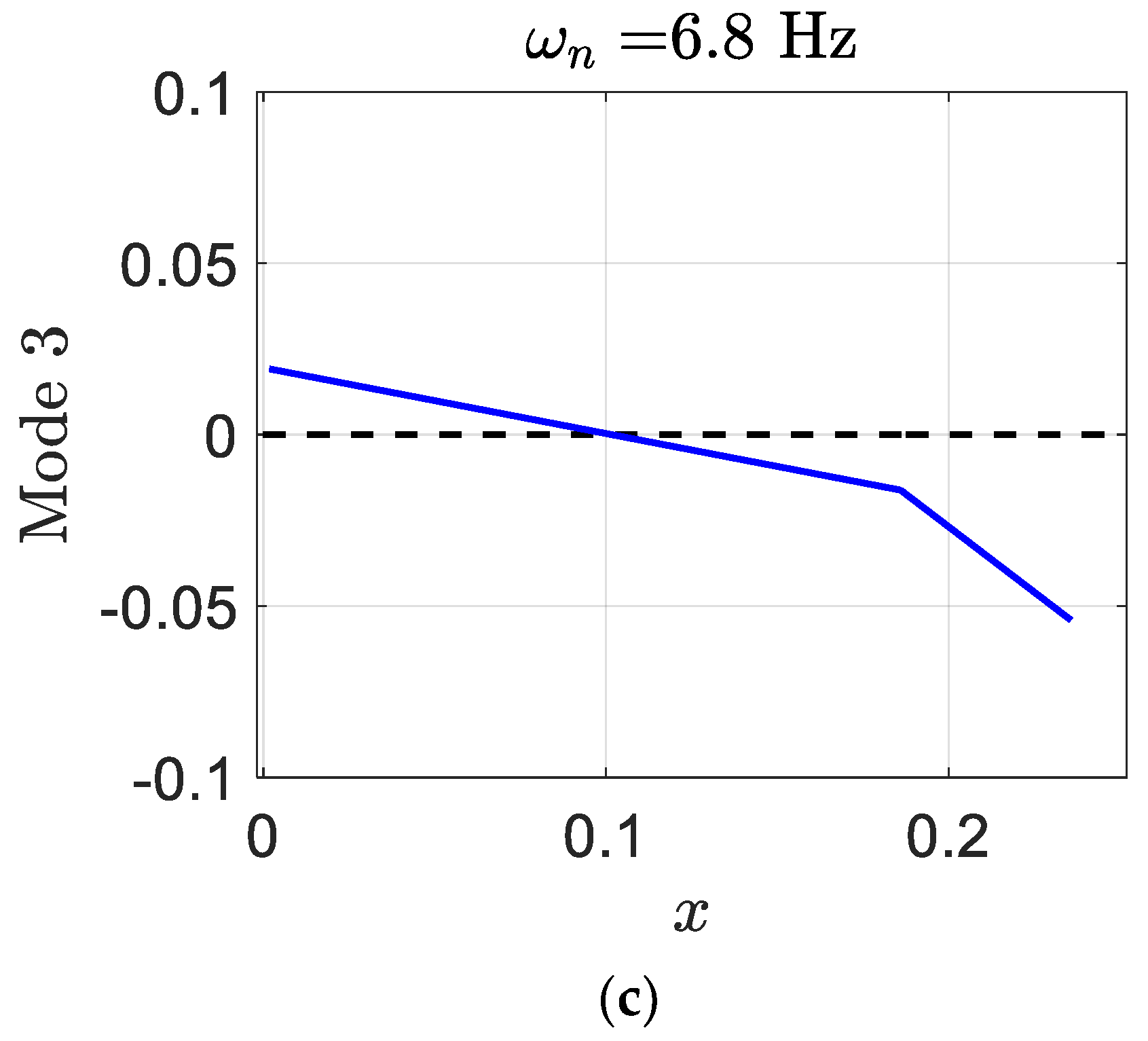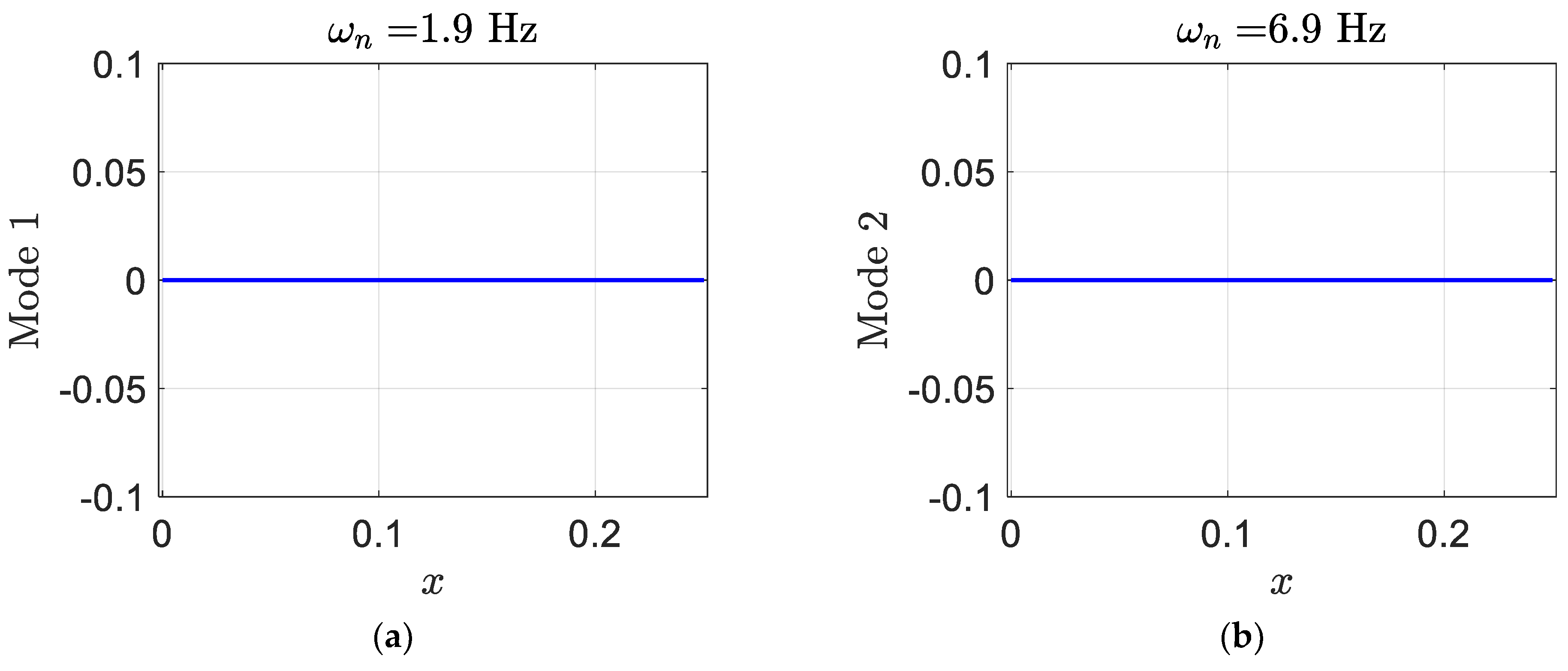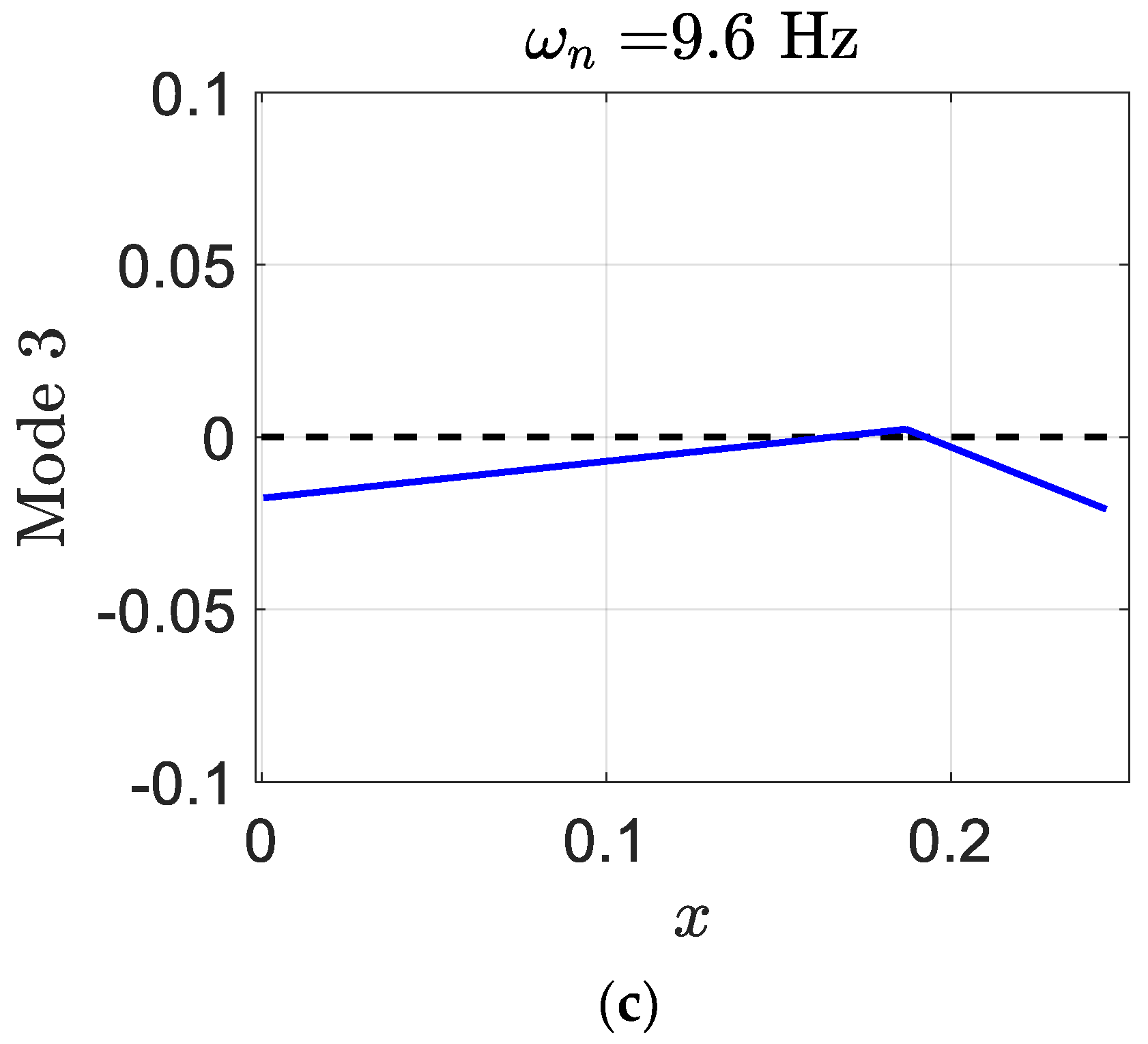1. Introduction
In modern blades, because of high flexibility, aeroelastic analysis is crucial. To maximize the blade aerodynamic performance, it is very important to control aeroelastic instability [
1,
2]. The flutter phenomenon is one significant aeroelastic analysis. Flutter can affect negatively the blade performance even it can cause to redesign the blade. In modern blades, preventing flutter is crucial due to its effect on the long-term durability of the blade structure, energy efficiency of the system, operational safety, and performance [
3,
4,
5,
6,
7].
For many years, smart materials as piezoelectric materials have been used in blade structures. Piezoelectric materials can operate as actuators and/or sensors on a blade. They can perform as dampers and actuators to control the blade aeroelastic behavior. In fact, implementing piezoelectric materials can avoid redesigning the blade which can significantly delay flutter [
8,
9]. These materials have been implemented on an adaptive blade with active aeroelastic control [
10]. They have also been used in honeycomb materials [
11]. Moreover, they can be implemented as vibration damping to control a plate under forcing function and time-dependent boundary moments [
12]. In addition, piezoelectric materials can perform as flutter controllers by using the finite element method in damaged composite laminates [
13]. Those materials can be used to study aeroelastic flutter analysis on thick porous plates [
14]. Moreover, piezoelectric actuators and sensors have been investigated in aeroelastic optimization [
15]. The blade’s aeroelastic behavior can be effectively modified by implementing piezopatch including a shunt circuit. Previously, there were some practical limits in the existing low-frequency range in aeroelastic phenomena because of the large size required inductance for passive aeroelastic control. However, nowadays, having a small-size inductor combined with a piezopatch can facilitate passive aeroelastic control [
16]. Practically because of having too large internal resistance, standard inductors are not appropriate to be combined with a piezopatch for resonant shunt applications. By using closed magnetic circuits with high-level-permeability materials, it is possible to design large inductance inductors which have high-quality factors.
Damping in the blade structure without causing any instability can be augmented by using shunted piezopatches. Furthermore, shunted piezopatches are simple to apply and need little to no power. Their hardware needs piezoelectrics with a simple electric circuit which includes a capacitor, an inductor, and a resistor. The shunted piezopatches consume the energy created from the blade vibrations to control the blade aeroelastic vibration, which can reduce the oscillations of specific frequencies and modes.
In this paper, the flutter speed of a simple aeroelastic system can be increased by using piezoelectric materials. One system is a 2D blade with two piezoelectric patches which had flapwise and edgewise plunge DOFs as well as rotational DOFs. Later, another system used is a 2D blade including a piezoelectric patch with plunge, pitch, and control rotational degrees of freedom (DOFs) subjected to unsteady aerodynamic loads. The work objective was to present the effect of piezoelectric patches that can influence effectively a simple smart blade system with rotational effects.
In
Section 2, the smart blade equations of motion with flapwise and edgewise plunge and rotational DOFs were described to solve those equations to calculate the flapwise and edgewise plunge velocities, displacements, electrical currents, and electric charges as well as rotational velocities and displacements. Then, the system fixed points and their stability around those points were studied to present the system response. Example 1 shows the considerable decay in the vibration of a smart blade in comparison to that in the vibration of a regular blade.
Section 3 shows a smart blade with plunge, pitch, and control DOFs and two piezopatches with flapwise and edgewise plunge and rotational DOFs to obtain the equations of motion under unsteady aerodynamic loads. Solving the system of equations provides the flapwise and edgewise plunge velocities, displacements, electrical currents, and electric charges as well as the pitching velocity, rotation, electrical current, and electric charge. Afterwards, by obtaining the flutter speed, we indicated how adding two piezopatches can effectively defer the flutter.
In
Section 4, a smart blade with plunge, pitch, and control DOFs and piezopatches with plunge and pitch DOFs are presented. The results showed that the flutter speed can even be further raised by having three piezopatches.
In addition, the smart blade concept presented in this work can be applied to increase the performance of renewable energy devices such as wind turbine and marine turbine blades [
17,
18].
3. Smart Blade with Plunge, Pitch, and Control DOFs and Piezopatches with Plunge DOFs
Figure 9 depicts a 2D smart blade with plunge, pitch, and control degrees of freedom. In the model, there are an airfoil with two piezoelectric patches in the flapwise and edgewise plunge DOFs. The system includes flapwise and edgewise plunge, pitch, and control degrees of freedom (DOFs) indicated by
,
,
, and
, respectively. The control surface angle around its hinge, located at distance
from the leading edge, is represented by the DOF
and the stiffness of the control surface is denoted by
.
Using the Lagrange’s equations and the Kirchhoff’s law leads to the equations of motion as:
where
,
,
,
,
,
,
,
,
,
,
,
,
,
,
,
,
,
,
,
, and
are defined as in Equation (2) and the rest are as follows:
| static mass moment of the blade around the pitch axis |
| static mass moment of the control surface around the hinge axis |
| control surface moment of the inertia around the hinge axis |
| Product of the inertia of the blade and the control surface |
| lift |
| pitching moment of the blade around the pitch axis |
| pitching moment of the control surface around the hinge axis |
By having unsteady aerodynamics, the lift and moments can be given as follows [
17,
18]:
Substituting Equations (12)−(14) into Equation (10) provides a set of equations of motion only in the time-dependent form and can be solved numerically such as using the backward finite difference scheme in numerical integration [
20]. However, the equations of motion can be given as ordinary differential equations by using the exponential form of the Wagner function’s approximation. These equations can be solved analytically rather than numerically; therefore, they would be much more practical [
21,
22]. The Wagner function’s approximation can be presented as:
where
,
,
, and
.
The equations of motion in the full unsteady aeroelastic form can be given as follows:
where
represents the displacement and the charge vector,
gives the aerodynamic states vector,
presents the Wagner function,
is the inductance and structural mass matrix,
represents the aerodynamic mass matrix,
gives the structural stiffness and resistance matrix,
is the aerodynamic stiffness matrix,
represents the influence matrix of aerodynamic state,
gives the initial condition excitation vector, and
and
present the aerodynamic state equation matrices.
Equations (14) can be formed in purely ordinary differential equations in the first order by the following equation:
where
where
is the
state vector,
,
is a
unit matrix,
is a
zero matrix,
is a
zero matrix,
is a
zero matrix, and
is a
zero vector. The initial condition is
. The initial condition
, which plays an excitation role, can decays exponentially. In this work, in order to reach steady-state solutions, the initial condition is eliminated; hence, Equation (15) can be written as:
Example 2. A smart blade with plunge, pitch, and control DOFs and a piezopatch in flapwise and edgewise plunge DOFs.
As the second example, a smart blade with plunge, pitch, and control DOFs (
Figure 10) is considered with the following parameters [
19]:
| |
| |
| |
| |
| |
| |
| |
| |
| |
| |
| |
| |
| |
Running the simulation gives the flutter speed of
which presents an
increase in the regular blade flutter speed with the same characteristics without piezoelectric patches.
Figure 10 shows the regular and smart blade variations of the damping ratio with respect to the velocity or airspeed of airflow. It is clear that having piezoelectric patches on the blade can effectively increase the flutter speed.
Figure 11 shows the eigenvalues real part versus the velocity of freestream. Again,
Figure 11b indicates the flutter speed of the smart blade can be effectively increased in comparison to that of the regular blade one.
Figure 12 depicts the imaginary part of eigenvalues versus the freestream velocity.
Figure 12b indicates the flutter speed of the smart blade can be effectively increased in comparison to that of the regular blade one.
Equation (8) can be used to form the matrix and its eigenvalues and eigenvectors can be obtained for two different airspeeds, and the flutter speed, . The structural states dynamics of the smart blade can be represented in eight complex eigenvalues. The complex eigenvalues of the regular blade are conjugate as the complex eigenvalues of the smart blade. Six real eigenvalues belong to the aerodynamics states dynamics. Moreover, the piezoelectric states dynamics include four real eigenvalues. The first three elements of each eigenvector give the structural velocities, and the flapwise piezoelectric electrical current is given by the fourth element. structural displacements can be obtained from the next three elements, and the flapwise piezoelectric electric charge is given by the eighth element. The edgewise velocity can be obtained from the ninth element, the edgewise displacement can be represented by the tenth element, the edgewise piezoelectric electric charge is given by the eleventh element, and finally, the last next element correspond to aerodynamic state displacements.
For the three structural modes, the smart blade eigenvalues at
are as follows:
and its corresponding eigenvectors which represent the smart blade structural mode shapes are shown as follows:
where, in each mode shape, the flapwise plunge displacement is presented by the first element, the pitch angle can be indicated by the second element, the control surface angle is presented by the third element, and the edgewise plunge displacement is given by the last element. Generally, since the degrees of freedom of aeroelastic systems are coupled to each other, they cannot occur independently. Mostly, in modes one and two, there are control surface and pitch displacements. The smart blade mode one has a significant pitch angle in comparison to the regular blade.
Figure 13 depicts the deformation of the three modes of the smart blade. In addition, the value of the pitch in mode one is high; however, the value of the pitch in mode two is zero.
Furthermore, the eigenvalues of the smart blade at an airspeed
can be as follows:
and its corresponding mode shapes are shown as follows:
The real parts of
is much more negative in comparison to eigenvalues at an airspeed
, and the value of
real part is almost zero. Moreover, at
, the value of the pitch in mode one is significant, as shown in
Figure 14.
In the next section, a smart blade including three DOFs and two piezopatches in the plunge and pitch DOFs is used to compare its aeroelastic behavior with a regular blade, and investigate how the flutter phenomenon can be postponed more by implementing the third piezopatch on a smart blade.
4. A Smart Blade with Plunge, Pitch, and Control DOFs and Piezopatches in Plunge and Pitch DOFs
In this section, there is a smart blade with plunge, pitch, and control DOFs in which there are three piezopatches, two in the flapwise and edgewise plunge DOFs, and the third one in pitch DOFs, as shown in
Figure 15. The same characteristics of the three smart blade are considered in this system.
The smart blade equations of motion can be written by considering the Kirchhoff’s law and the Lagrange’s equations as:
where
,
,
,
,
,
,
,
,
,
,
,
,
,
,
,
,
,
,
,
,
,
,
,
,
,
,
,
,
,
,
,
,
,
, and
are defined as in Equation (11),
is the piezoelectric material pitch inductance,
is the piezoelectric material pitch resistance,
is the piezoelectric material pitch capacitance,
is the electromechanical coupling of the pitch, and
is the electric charge of the pitch. The electromechanical coupling of the pitch,
, depends on the coupling coefficient of the pitch,
, and the capacitance of pitch,
, and it can be obtained by
.
The aeroelastic equations of motion in the full unsteady form can be written as follows:
where
is the displacement and charge vector.
In order to represent Equation (22) in purely ordinary differential equations in the first-order form, one can use the following equation:
where
where
is a
state vector,
,
is a
unit matrix,
is a
zero matrix,
is a
zero matrix,
is a
zero matrix, and
is a
zero vector. The initial condition is
. The initial condition
, which plays an excitation role, can decay exponentially. In this work, in order to reach steady-state solutions, the initial condition is eliminated; hence, Equation (20) can be written as:
Example 3. A smart blade with plunge, pitch, and control DOF and piezopatches in plunge and pitch DOFs.
In this example, one more piezopatch is implemented in the pitch DOFs of the example-two smart blade to control vibrations. As shown in
Figure 11, a smart blade is considered which has plunge, pitch, and control DOFs. Furthermore, there are three piezopatches, two in plunge DOFs and one in pitch DOFs. The smart blade has the same characteristics for the smart blade of example two. It assumes that
,
,
,
,
,
,
and
, the parameters of the pitch piezopatch as the coupling coefficient of the pitch
, the piezoelectric material pitch capacitance
, the piezoelectric material of the pitch inductance
, and the piezoelectric material of the pitch resistance
[
19].
The results of simulation showed that having one more piezopatch in the pitch DOFs can suppress the pitch mode flutter phenomenon, as shown in
Figure 16. Therefore, there is possibility to remove flutter in the pitch DOFs by possessing three piezopatches, two in the plunge DOFs and one in the pitch DOFs. However, the flutter phenomenon appears with a higher speed in the flapwise plunge DOFs.
Figure 16 indicates flutter happens at
in the control DOFs in the smart blade with three piezopatches. The new flutter speed value shows that it is increased by
in the smart blade in comparison to the one of a regular blade which has the same characteristics without a piezopatch. In addition, the new flutter speed is increased by
in the smart blade in comparison to the one of a smart blade, which possesses the same characteristics and only two piezopatches in the flapwise and edgewise plunge DOFs. Obviously, implementing three piezopatches can suppress the pitch mode flutter phenomenon; however, it appears in the flapwise plunge mode with a higher speed, as depicted in
Figure 16b.
Moreover,
Figure 17 shows the eigenvalue real parts versus the freestream velocity.
Figure 17b depicts clearly flutter is removed in the pitch mode but it happens in the flapwise plunge mode with a higher speed. It is also clear that the flutter speed of the smart blade with three piezopatches is increased in comparison to the flutter speed of the smart blade with only two piezopatches.
Furthermore,
Figure 18 indicates the eigenvalues imaginary parts versus the freestream velocity. According to
Figure 18b, it is clear that flutter happens in the flapwise plunge mode and the smart blade flutter speed is effectively increased in comparison to the regular blade one.
Equation (26) can be used to form the matrix Then, its eigenvalues and eigenvectors can be obtained for two different airspeeds, and the flutter speed, . The smart blade structural states dynamics can be represented by eight complex eigenvalues. Similar to the regular blade eigenvalues, these complex eigenvalues are conjugate. Six real eigenvalues are for the aerodynamics states dynamics. Moreover, six real eigenvalues represent the piezoelectric states dynamics. The first four eigenvector elements provide structural velocities, the next four elements give structural displacements, the next six elements provide aerodynamic state displacements, and finally, the last six elements correspond to piezoelectric electric charges.
At
, the eigenvalues of the smart blade for the three structural modes can be as follows:
and their corresponding eigenvectors can represent the smart blade structural mode shapes as:
Where, in each mode shape, the first element provides the flapwise plunge displacement, the second element presents the pitch angle, the third element indicates the control surface angle, and the last element provides the edgewise plunge displacement. The degrees of freedom of aeroelastic systems are generally coupled to each other and cannot appear independently. Mainly, flapwise plunge displacements and pitch and control surface angles happen in mode one; however, pitch and control surface angles happen in mode three. Mode one contains significant positive control surface angles; however, mode three includes significant negative pitch angles.
Figure 19 shows the deformation of the smart blade in the three modes. Clearly, the deformations of the smart blade are similar in pitch and control with opposite signs in modes one and three.
Furthermore, at an airspeed
, the smart blade eigenvalues can be shown as follows:
and their corresponding mode shapes are shown as follows:
The real parts of
and
are much closer in comparison to eigenvalues at an airspeed
and the real part of
and
are almost zero. In addition, at
, all mode shape components of
and
become almost zero, and there is a significant control angle in mode three, as depicted in
Figure 20.
5. Conclusions
In this paper, it has been shown how by using piezoelectric patches and considering the blade rotational effect, the flutter can be delayed on a smart blade.
Section 2 represents a smart blade system response with only plunge and rotational DOFs. Clearly, the oscillations of the smart blade can be effectively decayed in a very short time by implementing efficient flapwise and edgewise piezopatches. Almost in
, the vibration of the smart blade flapwise velocity with only plunge and rotational DOFs can be decayed. However, the vibration of the regular blade flapwise velocity without a piezoelectric patch needs around
to decay. Furthermore, the vibration of the smart blade edgewise velocity with only plunge and rotational DOFs can be decayed in
however, the vibration of the regular blade edgewise velocity without a piezoelectric patch needs around
to decay. In addition, in
, the vibration of the smart blade flapwise displacement with only plunge and rotational DOFs can be decayed; however, the vibration of the regular blade flapwise displacement without a piezoelectric patch needs around
to decay. Moreover, the vibration of the smart blade edgewise displacement with only plunge and rotational DOFs can be decayed in
; however, the vibration of the regular blade edgewise displacement without a piezoelectric patch needs around
to decay. In the rotational oscillation, the vibration of the smart blade rotational velocity with only plunge and rotational DOFs can be decayed in
however, the vibration of the regular blade rotational velocity without a piezoelectric patch needs around
to decay. Furthermore, the vibration of the smart blade rotational displacement with only plunge and rotational DOFs can be decayed in
however, the vibration of the regular blade rotational displacement without a piezoelectric patch needs around
to decay. As explained in
Section 3, by using two piezopatches in the flapwise and edgewise plunge DOFs of a regular blade with three DOFs, the flutter speed can be postponed by
, which shows that the flutter speed is increased to a considerable value. Moreover, the results showed that how the flutter can shift from the flapwise plunge mode in a regular blade to the pitch mode in a smart blade. Later, it presents the effect of implementing one more piezopatch to a smart blade in the pitch DOF on the postponement of the flutter. The flutter speed in a smart blade can be postponed by
, which is a very considerable value.
